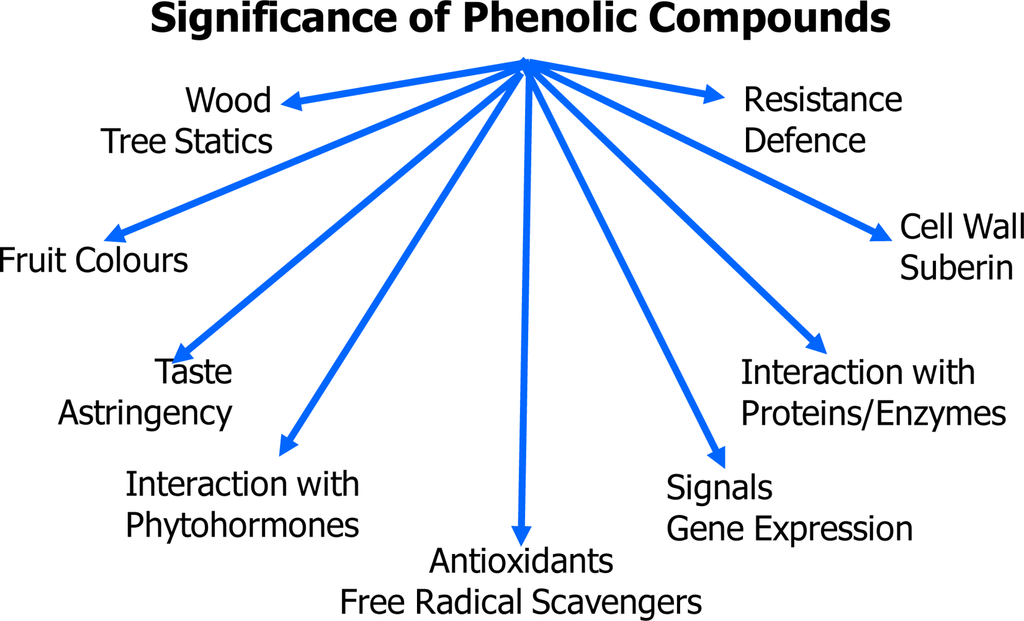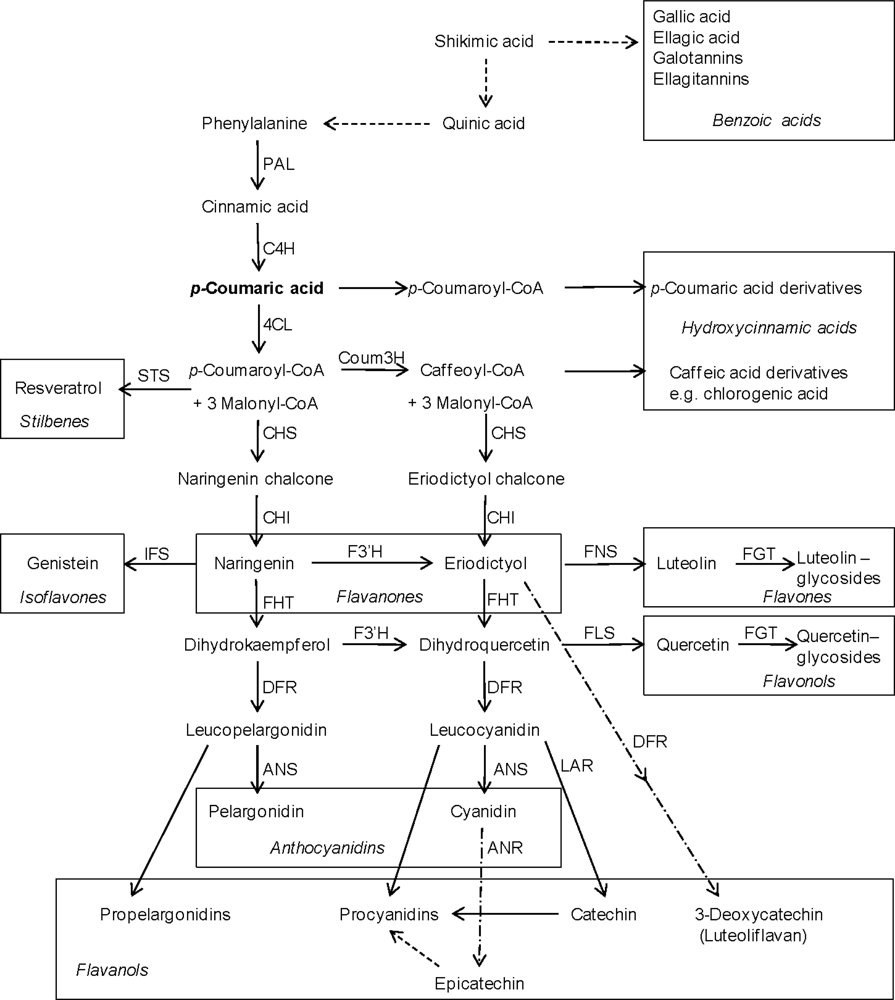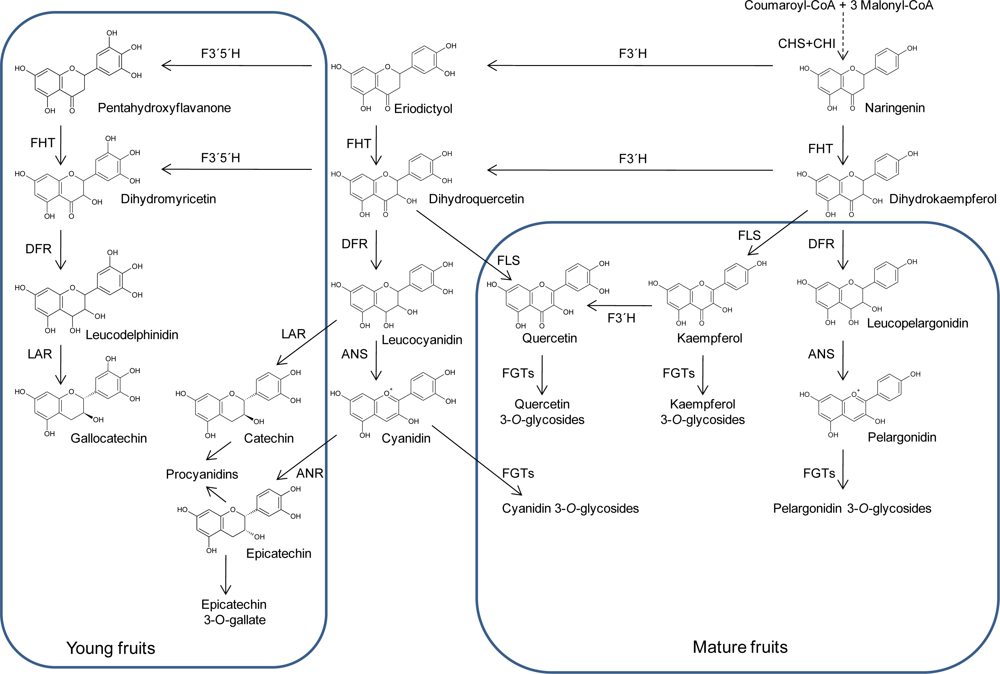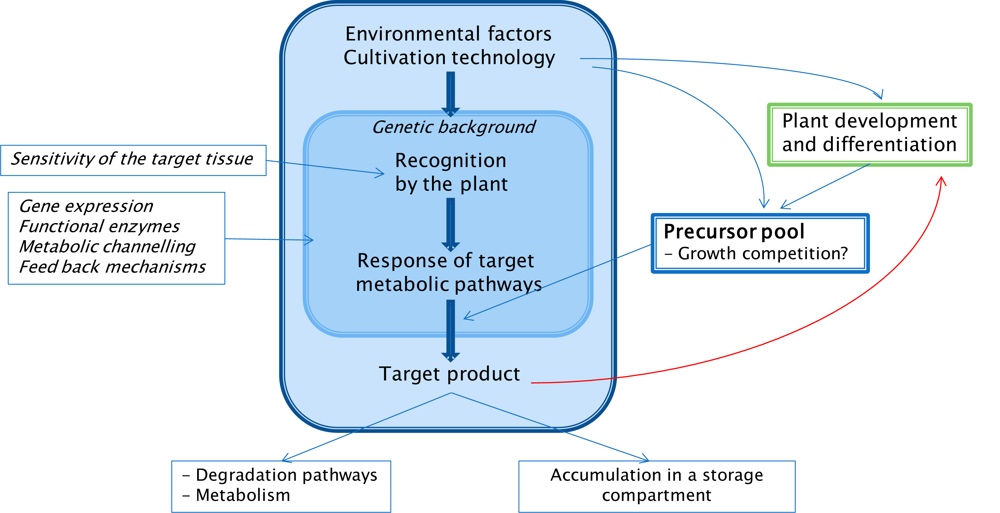Treutter, D. Managing Phenol Contents in Crop Plants by Phytochemical Farming and Breeding—Visions and Constraints. Int. J. Mol. Sci. 2010, 11, 807-857.

Figure 1. Multifunctionality of phenolic compounds.

Figure 2. Simplified scheme of the biosynthesis of selected phenolic compounds. Abbreviations: ANR: anthocyanidin reductase, ANS: anthocyanidin synthase, C4H: cinnamate 4-hydroxylase, CHI: chalcone isomerase, CHS: chalcone synthase, 4CL: p-coumarate:CoA ligase, Coum3H: coumaroyl 3-hydroxylase, DFR: dihydroflavonol 4-reductase, F 3’-H: flavonoiod 3’-hydroxylase, FGT: flavonoid glycosyltransferase, FHT: flavanone 3-hydroxylase, FLS: flavonol synthase, FNS: flavone synthase, IFS: isoflavone synthase, LAR: leucoanthocyanidin reductase PAL, phenylalanine ammonia lyase.

Figure 6. Flavonoid biosynthesis in strawberry fruits indicating development related pathways restricted to young and mature fruits, respectively [181].Note: F3’5’H = favonoid 3’,5’-hydroxylase, FGTs = flavonoid glycosyl transferases, other abbreviations see Figure 2.
Abstract
Two main fields of interest form the background of actual demand for optimized levels of phenolic compounds in crop plants. These are human health and plant resistance to pathogens and to biotic and abiotic stress factors. A survey of agricultural technologies influencing the biosynthesis and accumulation of phenolic compounds in crop plants is presented, including observations on the effects of light, temperature, mineral nutrition, water management, grafting, elevated atmospheric CO2, growth and differentiation of the plant and application of elicitors, stimulating agents and plant activators. The underlying mechanisms are discussed with respect to carbohydrate availability, trade-offs to competing demands as well as to regulatory elements. Outlines are given for genetic engineering and plant breeding. Constraints and possible physiological feedbacks are considered for successful and sustainable application of agricultural techniques with respect to management of plant phenol profiles and concentrations.
Conclusions
Several approaches for managing the contents and profiles of phenolic compounds in crop plants are presented. Among the cultivation technologies, the application of controlled mild stress conditions is sometimes propagated and several ideas are born from in-vitro experiments using tissue cultures or young seedlings but the up-scaling to a marketable produce often remains obscure. Results obtained by model experiments have to be thoroughly interpreted and carefully extrapolated to commonly used production methods.
The main route of targeted phytochemical farming (Figure 11) starts from the environmental factors modified by agricultural technology which must be recognized by the plant requiring sensitivity of the respective tissue. This step must be followed by a metabolic response depending on the expression of related genes which has to be transcribed to functional enzymes. Metabolic channeling may then direct to the accumulation of the target product if not disturbed by feedback mechanisms or by further metabolism or degradation. The farmers’ activities and/or changing environments also control growth and differentiation of the plant, thereby modifying precursor pools of the targeted secondary metabolism. The requested bioactive compound may exhibit physiological activity, thus affecting plant development and ecological performance. Increased resistance to biotic and/or abiotic stress situations may crop up as an added value of accumulating phenolic compounds.

Figure 11. Route of targeted pytochemical farming indicating constraints and physiological feed back.
Before such efforts in adapting cultivation technologies can be advised to the plant grower we should know:
○ the beneficial effects of target chemicals
○ the beneficial concentrations
for plant resistance
for human or animal health
○ environmental impacts on biosynthesis and metabolism
○ the role of the target phytochemicals in the plant.
A further prerequisite is an expected financial return. If a particular phenolic composition and concentration could be achieved, the question is how sustainable is the commercial return? Consumers’ attitudes may change or a reappraisal of particular bioactive components may happen based on advances in scientific knowledge. A curious example is the loss of the value of apples’ red skin colour as a marker for inner quality. Red coloration of many fruits like apple and strawberries may portend high fruit quality and optimal ripening stage based on the often observed biosynthetic relation to developmental processes in such fruits. High taste quality correlates with red pigmentation of old weakly colored apple cultivars (Figure 3) [74]. This may account for the consumers’ preferences since about 50% of the consumers indicate fruit color as a main selection criterion [351–353]. This contributes to higher prices for apple fruits for instance grown in the mountains of South Tyrol with prices attained by the growers of 45 €-Cents per kg as compared to the price for fruits grown in the valley with 35 €-Cents per kg [354]. Another study in 1986 revealed a 10% higher price for ‘Roter Boskoop’ as compared to the ‘Gelber Boskoop’ and more than 60% higher price for red mutants of ‘Jonagold’ in comparison to the standard ‘Jonagold’ [355]. The higher economic value, however, enforced the fruit growers and breeders to focus on mutants which accumulate anthocyanins even under low light conditions. Since most of the other fruit characteristics remained unchanged the red skinned mutants replaced the original cultivars to a high extent. This was observed for the old apple varieties ‘Gelber Boskoop’, ‘Gravensteiner’, ‘James Grieve’ which have been replaced by red mutants. Among the new apple varieties ‘Jonagold’, ‘Elstar’, ‘Gala’, ‘Braeburn’, ‘Fuji’, ‘Topaz’, ‘Pinova’ many red mutants have been selected up to now [356–361]. By that kind of selection the value of the red apple skin as a useful marker for high fruit quality with optimal organoleptic properties is strongly reduced. This could be confirmed for red-skinned mutants of ‘Gala’ and ‘Jonagold’ where the correlation between red skin and ripening stage is poor [353]. Nevertheless, the red color of apples is paid for!
Despite such uncertainties with respect to the sustainability of a measure for phytochemical farming, it is inevitable to increase our knowledge on optimization and influencing the composition and enhancement of “bioactive” metabolites in plant foods (namely fruits and vegetables) by breeding (classical methods, genetic engineering), production technology, storage and processing. At the same time, the plant grower should keep an eye on the progress in nutritional science and nutrition medicine which may state the biologic activities of phenolic compounds more precisely. At the moment, it may not be recommended starting the production of plant foods with an attributed enhanced nutritional quality for a common market. However, the production of fresh “functional food” with defined health claims may be favorable for a premium market segment. In future, it may be expected for the global market that minimum quality of plant foods will be defined on the base of their content of bioactive components.
This paper is dedicated to Walter Feucht on the occasion of his 80th birthday.
See more at:
Nenhum comentário:
Postar um comentário